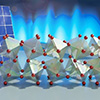| Jul 18, 2023 |
|
(Nanowerk News) Halide perovskites are a recently developed class of materials. They have applications in solar energy and radiation detection. They are also potentially useful for thermal harvesting—capturing heat from engines and other sources.
|
|
Cesium lead bromide (CsPbBr3) is among the simplest members of the broad family of halide perovskites. Understanding the atomic structure and dynamics of lead-halide perovskites (LHPs) is critical for scientists developing these materials for specific applications. LHPs exhibit structural instabilities and large atomic fluctuations that scientists believe affect their optical and thermal properties. However, scientists do not fully understand the atomic motions in LHP.
|
|
In this study (Nature Materials, “Two-dimensional overdamped fluctuations of soft perovskite lattice in CsPbBr3“), scientists used neutron and X-ray scattering with computational modeling to reveal the unusual behavior of coordinated atomic motions in LHP. Specifically, researchers found the atomic vibrations (phonons) of bromine octahedrons (see image) have large amplitudes but cannot oscillate for long amounts of time.
|
 |
| The atomic structure in an inorganic perovskite. Bromine atoms (red) at the corners act as “hinges” that allow the structure to flex. This inhibits the electrons from recombining and may enhance the efficiency of these materials for solar applications. (Image: Jill Hemman, Oak Ridge National Laboratory)
|
|
Instead, the vibrations are strongly damped. This is similar to when a guitar player places their palm on the instrument’s strings while strumming them, dampening the sound.
|
|
The damped nature of atomic vibrations in LHP could help electrons generated by photon absorption travel long distances in the material. This would improve the materials’ ability to generate electrical power. This discovery provides a new route to designing materials with tunable optical and thermal behaviors.
|
|
These materials have many potential applications. For example, they could reshape solar panel technology as well as waste-heat harvesting applications. In these applications, halide perovskites could lead to devices that are more efficient, cheaper, and easier to manufacture.
|
|
Understanding the interplay of phonon and electronic degrees-of-freedom is critical to controlling a wide array of energy materials. Cesium lead bromide is an interesting material that exhibits remarkably complex atomic dynamics in the simplest structure among the broad family of halide perovskites for photovoltaics, radiation detection, and potential thermoelectric applications.
|
|
This research explored the microscopic origin of strongly damped, anharmonic phonons in these materials by the combined use of neutron and X-ray scattering experiments at the Spallation Neutron Source and the Advanced Photon Source, both Department of Energy Office of Science user facilities.
|
|
The team included researchers from Duke University, Argonne National Laboratory, Oak Ridge National Laboratory, the National Institute of Standards and Technology, the University of Maryland, and Northwestern University.
|
|
The researchers’ analysis of the experimental results, combined with computer simulations, established that the strongly anharmonic lattice vibrations (that is, vibrations with poorly defined frequency and that do not persist for long times) are associated with unstable cooperative oscillations of bromine octahedra in the crystal structure, as illustrated in the image above. These motions modulate the electronic states near the bandgap and are thought to disrupt the recombination of photoexcited charges. Thus, anharmonic phonons and electron-phonon couplings could be key to enable the high-performance in photovoltaic and radiation detection applications.
|
|
The new understanding of the atomic vibrations of the crystal lattice provides a novel avenue to design materials with controllable optoelectronic and thermal properties for future energy harvesting and conversion devices.
|


